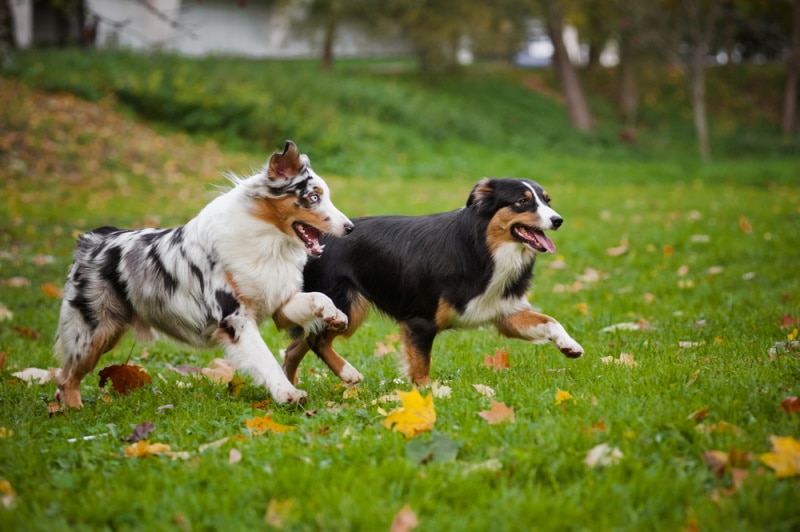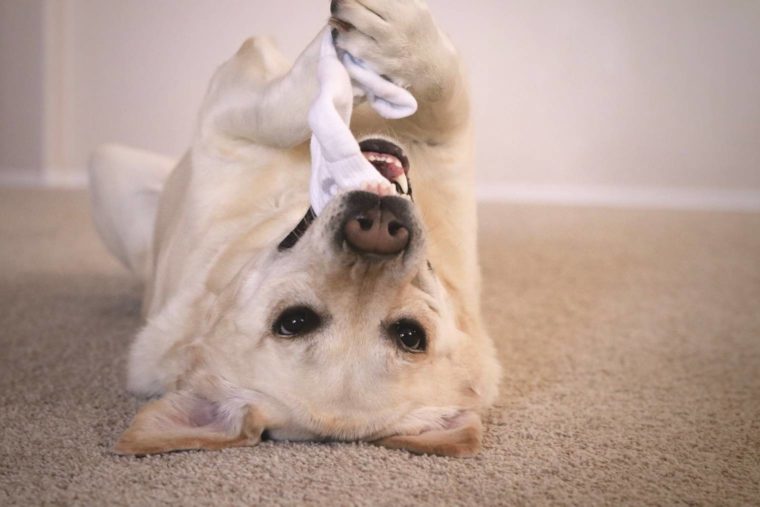
Click to Skip Ahead
Dogs are well known for eating things they shouldn’t. They are instinctive scavengers and will often chew and eat things such as socks (or other undergarments) as they smell exciting and have an interesting texture. You are likely reading this because your dog has swallowed some socks.
If your dog has eaten a sock this can be an extremely dangerous situation. You will need to contact your vet immediately to have your dog checked out. Any foreign object that your dog ingests can cause a blockage in the gastrointestinal tract. You may think that socks are soft and will easily pass through the guts or get digested, but this is not the case.
Socks are often made from synthetic materials such as nylon and polyester which are essentially plastics. These materials cannot be broken down why socks commonly get stuck and cause blockages.
My Dog Swallowed Socks, What Do I Do Now?
1. Ensure Your Dog Does Not Have Access to More Socks
Remove any items of clothing left lying around. Take your dog away from the place where they ate socks in case they try to eat anymore. Ensure there are no socks in your dog’s mouth. This is especially important if they are continually gagging and retching as this could be a sign they are choking. Try to determine what sort of socks they have eaten, and how many socks have been eaten.
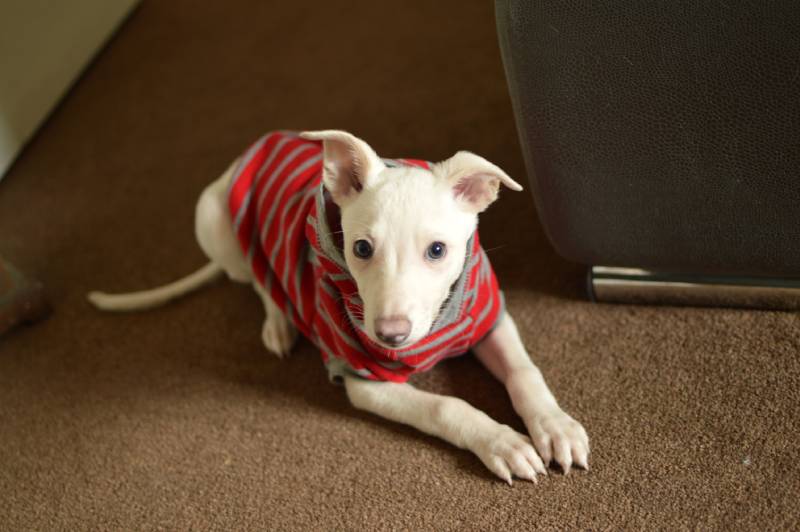
2. Call Your Vet Immediately
You need to get in contact with your vet straight away. Your dog may have only just swallowed a sock, or you may be suspicious they have swallowed one, but you don’t know for sure and therefore have no idea of the time scale. Either way, it is important to seek veterinary advice. Your vet will want to examine your dog and they will ask you some questions to gain a full clinical history. Questions they are likely to ask include:
If you don’t know how many socks your dog may have eaten, do you know how long they have been left unsupervised? Were there any ripped-up socks? Any information is useful. Keep calm and try not to panic, your vet will do everything they can to help you. It is important to listen carefully to the advice they give.
3. Do Everything Your Vet Tells You to Do
Don’t delay making your way down to the vet hospital. The sooner your dog is examined, the sooner they can receive the best treatment.
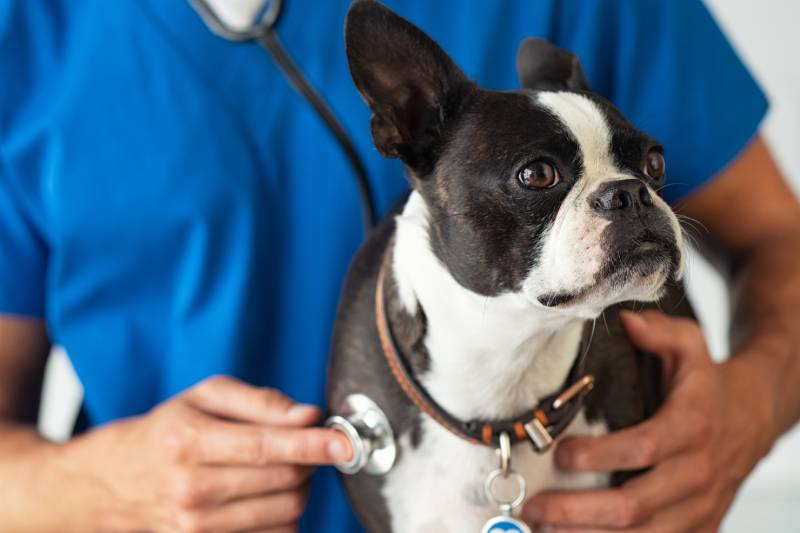
4. Do Not Attempt to Treat Your Dog at Home
Some dogs do end up passing socks out in their feces or vomiting socks back up. However, there is no guarantee your dog will do this. Even if they pass one sock, the other one may be still stuck somewhere. It is not advised to try and make your dog vomit at home, the only safe way to do this is under veterinary supervision.
Home remedies to induce vomiting are not reliable. Some of the chemicals that can be used to induce vomiting can be very dangerous for dogs. Often the use of home remedies can cause more trouble for your dog than ingesting the sock did.
5. Stay with Your Dog
Keep your dog close to you and don’t let them out of your sight. They may suddenly start to feel poorly or start vomiting and they may need your help. It is also important to stay with them to prevent them from running off or escaping as this will delay you bringing them to the vet to be treated.
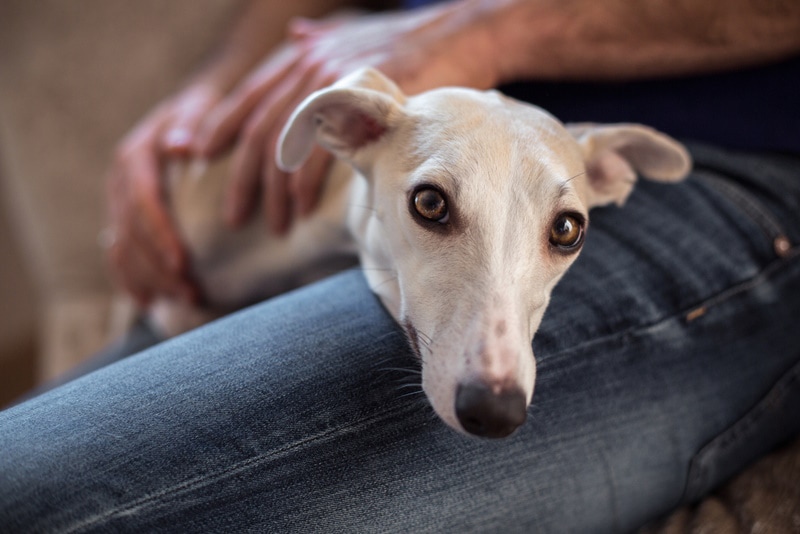
Dangers of Swallowing Socks
The main concern when your dog has swallowed a sock is that a blockage may occur in the gastrointestinal tract. Foreign bodies that are swallowed may become stuck anywhere in the body. A bowel obstruction can very quickly turn into a life-threatening situation. Initially, your dog may lose a large amount of fluid from vomiting and diarrhea and become dehydrated.
They may also be unable to absorb water from their large intestine which makes the situation even worse. The obstruction can cause serious damage to the bowel and can eventually cause it to perforate, which leads to septic peritonitis. This is a medical emergency, and your dog will require surgery.
In some instances, your dog may vomit the socks back up, or pass them through the guts. There is still always a risk that they will get stuck somewhere. Larger dogs are more capable of passing socks than smaller breeds. Smaller or thinner socks such as baby socks or pop socks are more likely to pass through with ease than thick football socks but there is never any guarantee.

Clinical Signs Your Dog Has Eaten a Sock
Whether you saw your dog eat a sock or you just noticed some socks are missing from the laundry pile, or even if you have no idea that your dog may have eaten anything, but they do have a tendency to scavenge, there are some telltale signs you can look out for.
Some dogs may attempt to vomit up the socks, and many are successful. Some dogs may try to be sick and continue to retch unproductively. Dogs with a blockage may be unable to keep anything down. This does depend on where the blockage is, some dogs will not even be able to keep water down.
If this is the case, immediate veterinary attention needs to be sought.
What Will Your Vet Do?
When you arrive at your vet, they will assess your dog to determine if they need any emergency treatment. This may include pain relief and intravenous fluid therapy. If they decide your dog is stable, they will carry on with some more diagnostic tests. They may run a routine blood test and urinalysis to see how healthy your dog is and to check there isn’t any other reason for the clinical signs seen.
They will want to take X-rays to determine the location of the socks and they may perform an ultrasound scan on the abdomen too. If they can see the location of the sock, or if they are suspicious, they will often perform an exploratory laparotomy to locate and remove the sock. This is a big operation where your vet cuts into your dog’s abdomen.
Your vet will find the sock and cut it out of the intestines where it has become lodged and then stitch your dog back up. Sometimes parts of the guts are damaged due to lack of oxygen supply, if this is the case, your vet can remove damaged parts and suture the intestines back together. In some cases, it is possible to retrieve the socks with an endoscope, which is a long bendy tube with a camera on the end.
Dogs can be very sick, and this surgery often saves their life. If an obstruction is left undetected or untreated, the guts can perforate causing septic peritonitis. This is a very serious situation and often results in death. The good news is that if the sock is discovered in good time, most dogs will recover from abdominal surgery rapidly.
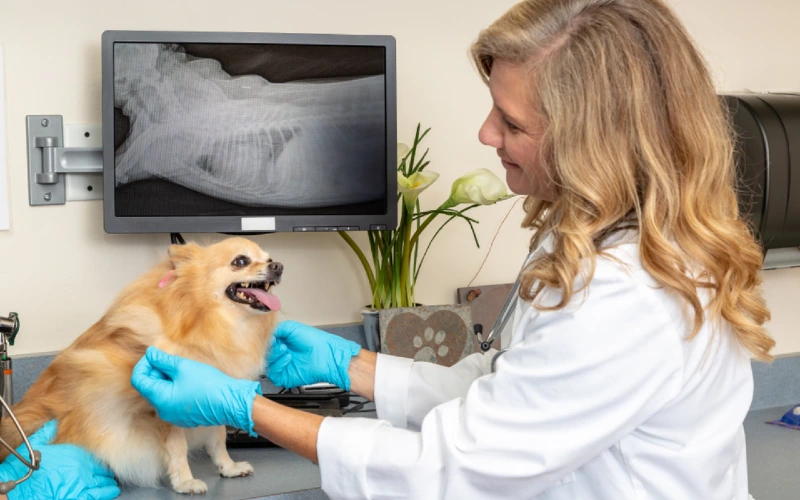
How to Prevent Your Dog Swallowing Socks
It can be difficult to keep your dog away from socks as they are usually all over the house, especially if you have a big family. They are small and easily dropped when carrying the laundry in so extra care must be taken. Don’t let your dog have access to any laundry around the house. Always ensure it is put away in drawers or wardrobes out of reach of your dog. Make sure all dirty socks are out in a basket that is dog-proof so they can’t root through and find them.
Don’t let your dog near the washing line or drying rack if you know they are likely to steal items of clothing from there. If your dog is a known chewer, consider crate training them for when they are left in the house on their own. Give them safe alternatives to chew such as puzzle toys to keep them occupied and mentally stimulated, and discourage your dog from chewing any human items such as slippers or socks in general.
Conclusion
It is very common for dogs to eat socks. They often pick up socks they find lying about the house. It is highly unlikely that your dog will be able to digest a sock, so they will need help getting rid of the sock one way or the other.
The consequences of eating a sock can be fatal but do not panic, your vet will be able to help you. It is best to contact your vet as soon as you are suspicious your dog may have eaten a sock. Prompt treatment is the best way to guarantee a good outcome. The longer the situation is left, the more likely complications are.
Featured Image Credit: Zachary Pennington, Shutterstock


